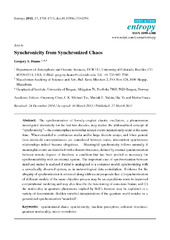Synchronicity from synchronized chaos
Peer reviewed, Journal article
Published version

Åpne
Permanent lenke
https://hdl.handle.net/1956/12358Utgivelsesdato
2015-03-27Metadata
Vis full innførselSamlinger
- Geophysical Institute [1185]
Originalversjon
https://doi.org/10.3390/e17041701Sammendrag
The synchronization of loosely-coupled chaotic oscillators, a phenomenon investigated intensively for the last two decades, may realize the philosophical concept of “synchronicity”—the commonplace notion that related eventsmysteriously occur at the same time. When extended to continuous media and/or large discrete arrays, and when general (non-identical) correspondences are considered between states, intermittent synchronous relationships indeed become ubiquitous. Meaningful synchronicity follows naturally if meaningful events are identified with coherent structures, defined by internal synchronization between remote degrees of freedom; a condition that has been posited as necessary for synchronizability with an external system. The important case of synchronization between mind and matter is realized if mind is analogized to a computer model, synchronizing with a sporadically observed system, as in meteorological data assimilation. Evidence for the ubiquity of synchronization is reviewed along with recent proposals that: (1) synchronization of different models of the same objective process may be an expeditious route to improved computational modeling and may also describe the functioning of conscious brains; and (2) the nonlocality in quantum phenomena implied by Bell’s theorem may be explained in a variety of deterministic (hidden variable) interpretations if the quantum world resides on a generalized synchronization “manifold”.
